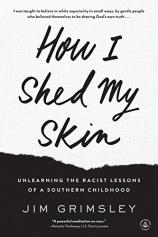How I Shed My Skin: Unlearning the Racist Lessons of a Southern Childhood
Review
How I Shed My Skin: Unlearning the Racist Lessons of a Southern Childhood
Growing up in Jones County, North Carolina, coming of age in the 1960s, Jim Grimsley has a powerful tale to tell --- about change, and the fears and triumphs that go with it.
Award-winning novelist Grimsley (WINTER BIRDS, DREAM BOY) has composed something akin to a confession --- the confession of the innocence of childhood overshadowed by place and race. In Jones County in 1850, the black population outnumbered the white, and yet it was considered a wealthy region --- a place where whites owed their wealth to the enslavement of blacks. Fast forward just over 100 years: in 1966, Jones County still had a substantial black population, was no longer considered a wealthy place, and was confronting the federal mandate that black and white children learn together in schools that once had been completely segregated. Grimsley was white and, at 11 years old, accustomed to contact only with other white children. Gradually, he and his fellow white students would become a racial minority.
"Growing up in Jones County, North Carolina, coming of age in the 1960s, Jim Grimsley has a powerful tale to tell --- about change, and the fears and triumphs that go with it."
Grimsley admits that for no reason he could have explained, he was initially fearful of being in a classroom with black children. “To the extent that I understood the fear, I knew it came from a feeling that the world was rearranging itself, the shift being bigger than I could take in.” He makes the point that racism is never specifically taught, yet it’s something everyone knows. In Jones County, everyone knew his or her place in a complex hierarchy of skin color and varying degrees of wealth, inheritance and education. But as the school years passed, Grimsley had the chance to confront his own racism, and that of his white classmates, in ways that were both subtle and, at times, extremely jarring. When a black girl kissed him, it was a turning point.
In high school, even some of the poorest white parents managed to scrape together the funds to send their children to private whites-only schools. Grimsley’s dysfunctional family made no such efforts. And though the melding of the public schools had its challenges, at a certain moment in high school, it started to take with Grimsley. He began to see his black acquaintances as “telling the truth about racism” in a way that his white cohort did not; he started siding with the black kids on parlous issues, though at this remove, he does not credit himself with special insights, only stating that “integration happened,” and he had to make his accommodation to it. The fact that he was also realizing he was gay perhaps made him more sensitive to issues of discrimination, but more significantly, he believes, it was simple propinquity that turned the key: “I had…grown to know black people as friends and equals.” In that way, for that conflicted young man, integration worked.
In a poignant final episode, Grimsley, who had not been back to Jones County since high school, returned for a class reunion. He found there both the sweetness of reminiscing with one of his black female friends and the bitterness of hearing voiced once again some of the old, ugly rhetoric of race among the whites. He concludes that, despite the continued crossfire, he and his classmates --- “cool and slouched, shy and lost” --- desegregated the schools of Jones County and became instruments of its history.
Reviewed by Barbara Bamberger Scott on April 24, 2015
How I Shed My Skin: Unlearning the Racist Lessons of a Southern Childhood
- Publication Date: February 23, 2016
- Genres: Memoir, Nonfiction
- Paperback: 288 pages
- Publisher: Algonquin Books
- ISBN-10: 1616205342
- ISBN-13: 9781616205348





